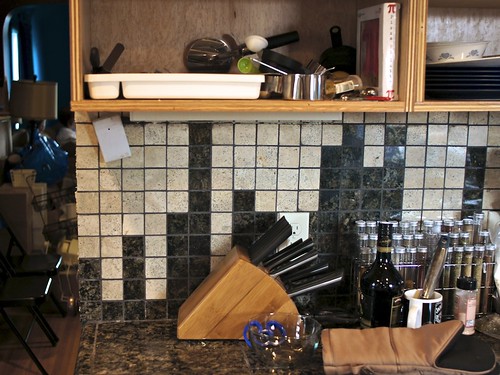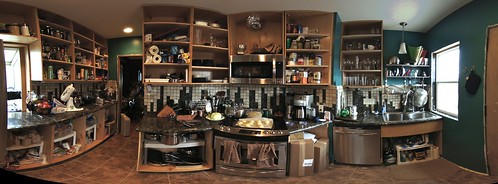A Tale of a St. Pi-trick’s Day Photo Challenge

THE BACKSTORY
Yesterday, I had the privilege of attending a St. Pi-trick's Day party, hosted at the home of Marie Porter of Celebration Generation fame. You may have seen her geeky cakes, costumes, and/or other artistic endeavors popping up around the web.
You may have even seen stories about how her home was hit by a tornado around a year ago, and how part of her home's restoration involved the installation of a pi-themed backsplash in its amply-used kitchen. She and her husband, Porter, have received a flood of attention across the web for immortalizing the value of pi in tile. In fact, Mad Art Lab linked to their project in a previous Quickies post.
I was thrilled to be able to go to their party, which was to combine Pi Day (March 14th) festivities with St. Patrick's Day (March 17th) celebration. Marie and Porter host excellent parties, and the theme guaranteed that the food would be plentiful, nerdy, and intoxicating. On top of that, I'd finally be able to see their home for the first time since they bought it… and I'd see the now-eFamous pi backsplash.
Now, Porter is a rather talented photographer himself, so Marie and Porter have no shortage of photos of their kitchen. However, given that I have quite a different photographic eye than Porter, I figured it wouldn't hurt to ask if I could make a panorama of their kitchen. They agreed, even though the renovation isn't yet complete. (As you'll see below, the cabinet doors have not yet been installed.) I promised to return later and do a second panorama after it was all finished. Today's photos would be a trial run.
THE CHALLENGE
I arrived with my camera gear, and was immediately plied with handmade alcohol-laden truffles, pastries filled with corned beef, and beer. I was given a full tour of the house, which also includes things like bathroom tile fixtures that immortalize the Fibonacci sequence (!) and a gingerbread model of their tornado-trashed home (!!). Photography was forgotten for a while.
Eventually, I wandered into the kitchen and remembered that I had a mission to fulfill before feasting myself into a coma on Marie's amazing food.
I knew from talking with Marie online and from Porter's photos that the kitchen was an odd L-shape and challenging to photograph. It's also fairly small, so it's difficult to stand back and get a single photo that showed off the entire thing. I also realized (silly me) that in the middle of a party, it was going to be full of food and food-making stuff. It also had some challenging light situations, with bluish daylight streaming in from two side windows, and warm, yellowish light from overhead. Ah. This was going to be a little tricky.
Usually, when I do a photo-stitch panorama with my camera, I use my 28mm lens: a neutral lens that is neither telephoto nor a wide angle on my particular camera, which means there is a minimal amount of image distortion in the final photo. Here's an example of a panorama I've made in the past, created from 18 separate 16 megapixel photos, shot with the 28mm lens. In that example, you can see where the photos line up at the edges.
However, when I put my back against the wall and took my first photo for the panorama, this is what I got:
Well, you can see the start part of pi here in the black tiles (3.1415KNIFEBLOCKSPICERACK), but I could also see the flaw in my cunning plan. If I was going to get a panorama of the full kitchen, including cupboards above and below the backsplash, it would take somewhere around 50-70 photos to cover all of it visually. Since the sample panorama I linked above took hours of work with only 18 photos, and since I'm, uh, lazy, I figured I should explore solutions that would be less of a pain in the ass.
Luckily, I own one of these:
This, my friends, is my 8mm fisheye lens. (Yes, I just used Instagram on my iPhone to take a photo of it. I feel slightly ashamed.)
If you're not a photography nerd, here's what that 8mm means: the focal length of a camera lens generally indicates if it will be zoomed-in (higher numbers) or wide-angle (lower numbers). If you are trying to photograph a bird from hundreds of feet away, you want a lens with a high focal length, because that's like using a pair of binoculars to look at the bird. If you're in a tiny space and you want to cram the far edges of the room into the picture, you want a wide angle lens with a small focal length.
On my camera, a Sony a580 with a 3/4 size sensor, I can stand in the same spot against that kitchen wall and get this result instead:
Hey, look! You can see so much more of that kitchen now, because the lens has a nearly 180 degree field of view. There's 111 digits of pi, right there, in one photo! And oooh… there are more tasty pastries on the stove!
There's a problem, though… there are 159 digits of pi in that kitchen. The numbering sequence continues on a wall to the left, which is still outside the frame of the photo. Also, while the 8mm lens is great at cramming all that visual information into a single photograph, you can see a huge amount of distortion, particularly toward the edges of the frame. If I moved the camera to the left to get another photo of the remaining digits, the distortion changes, and it would be impossible to manually overlay the photos to get one seamless panorama. In the photo above, the stove appears to be facing slightly to the left; by shifting the camera to the left and putting the stove at the right side of the frame, it would seem to be facing even further to the left.
Ah, a dilemma. I figured I'd solve it later. I took three 8mm photos of the space, from right to left, then proceeded to eat and drink nonstop until nightfall.
TECHNOLOGY TO THE RESCUE
After my mild hangover subsided this morning, I pulled the photos from my camera and started to work. I soon discovered that, thanks to the Internet, my 8mm dilemma was only a mild concern.
There are hundreds of panoramic photo stitching programs out there. They're all over the Internet. You can even buy them for your iPhone. Most cost money… in some cases, a lot of money.
Thankfully, I stumbled across a program called Hugin, which is a free, open-source photo stitching project. I've used it in the past on panoramas shot with a 28mm lenses, and it worked quite well. I just was surprised to learn that I could just input the focal length of 8mm, and the program didn't even bat an eye.
Go ahead and click that image. You can zoom into the photo on Flickr to see the finer details, including the mixer with a flame job.
As you can see, the distortion gets really weird in places. (Check out how the stove and the cabinet next to it warp, and how some of the upper cabinet shelves look like they have been broken in half. You can also see how the image doesn't extend to the lower left corner of the final image.) But hey… you can see the rest of the backsplash! (Or, rather, you would be able to see it if all the kitchen gear was out of the way.)
So, it's not a photo I'd submit to Better (Geek) Homes and Gardens, but I'd call it a successful test for the shot I'll get later, when the remodeling project is done.
WHAT'S WITH THAT WEIRD DISTORTION, ANYWAY?
The 8mm fisheye lens exhibits what is called barrel distortion. Wikipedia has a nice summary of it:
In "barrel distortion", image magnification decreases with distance from the optical axis. The apparent effect is that of an image which has been mapped around a sphere (or barrel). Fisheye lenses, which take hemispherical views, utilize this type of distortion as a way to map an infinitely wide object plane into a finite image area.
With any photo, we're essentially taking a spherical image (since we see the world as a 360 degree panorama centered upon our eyes) and forcing it onto a flat plane (the camera's sensor). If the segment of the field of view is small enough, there is little distortion. If it is big, there is distortion galore.
We see this in world maps all the time. Check out this Mollweide projection of the world. It's exhibits a similar warping as you see in my 8mm lens. However, if you just zoomed in on the top left-hand quadrant of Africa, you might not notice the distortion.
There's more than that going on in the panorama I created above. To get the stitched panorama, I also had to set the type of panorama projection I wanted in Hugin. Essentially, I was trying to undo some of the distortion of the 8mm lens by laying another type of (hopefully opposite) projection on top of it. Hugin's "architectural" setting mostly did the trick, as you can see above.
IN CONCLUSION…
The reason it was tough to take a photo of a kitchen-based representation of pi was because I was having problems with putting something spherical on a flat plane. The reason I was able to easily fix it was because Hugin uses pi to calculate and alter the distortion of the image.
Now I can't tell if pi is on my side or not.
I think I'll just stop here, eat some of Marie's apple pie, and solve this Sudoku puzzle.




